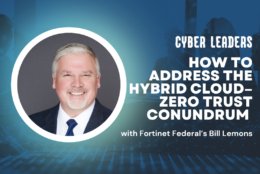SDFM The Business of Defense
-
The Office of the National Cyber Director this summer released a National Cyber Strategy Implementation Plan that includes 69 initiatives. But ONCD’s Nick Leiserson explains that the plan will not — really cannot — be static guidance.
September 15, 2023 -
It’s not even close to the end of the journey — there won’t be an end — but three Navy IT leaders share how the service achieved a working zero trust model that serves the vast majority of the users on its enterprise networks.
September 15, 2023 -
In DHS and NIST labs, researchers study known knowns but also unknown unknowns on the cyber horizon. We talk to three such researchers to learn about their work and about helping agencies become agile and resilient in the face of such cyberthreats.
September 15, 2023 -
Given that agencies are on the clock to adopt zero trust architectures by fiscal 2025, Fortinet Federal’s Bill Lemons offers tactics federal IT teams can take if going all in on cloud, which makes zero trust implementation easier, is not an option.
September 15, 2023 -
As agencies continue to evolve their cyber capabilities, some preparatory basics still apply. The Federal Drive’s Tom Temin talks with Infoblox’s Allen McNaughten to get the lowdown on three things agencies should still be doing.
September 15, 2023 -
The Federal Zero Trust Strategy emphasizes visibility. It matters because “that’s how you detect compromised controls, compromised appliances, compromised firewalls. … Look at the traffic because that’s where the truth is,” Gigamon’s Ian Farquhar says.
September 15, 2023 -
With the National Cyber Strategy putting a premium on securing technology supply chains, public-private collaboration as well as cross-vendor initiatives have become essential, shares Dell Technologies’ Daniel Carroll.
September 15, 2023 -
SBOM requests from agencies are becoming more common, points out Thales’ Gina Scinta — it’s a sign of the swift impact of the National Cyber Strategy in shifting the responsibility for ensuring secure software use within the government.
September 15, 2023 -
The White House wants agencies to emphasize cyber supply chain risk management. To do so, offers Palo Alto Networks’ Deontray Jones, agencies must implement cyber best practices consistently and holistically across their enterprises.
September 14, 2023 -
Dr. Marwan Haddad and Dr. Carl Steed go into detail with hosts Mark Masselli and Margaret Flinter about the existing research and approach to evidence-based gender-affirming care for youth
September 14, 2023 -
“Probably one of the single most effective process changes that agencies can do is for people to get over themselves and change their mindset. The world today is not the world 10 years ago,” says Splunk’s Juliana Vida, who offers ways to move forward.
September 14, 2023 -
CISA’s new Cyber Supply Chain Risk Management Office is developing training for federal employees and a maturity model to help agencies measure SCRM effectiveness. We get the details from the agency’s C-SCRM leader, Shon Lyublanovits.
September 13, 2023 -
The government’s federal chief information security officer shares progress update on where agencies stand on implementing phishing-resistant multifactor authentication, endpoint detection and response, and cultural changes to improve cyber posture.
September 12, 2023 -
A new program at the National Science Foundation is asking the question, what happens when algorithm graduate from training data to real world data that continues to expand and grow? Will the results remain as accurate?
September 12, 2023 -
Can your agency get access to cyber tools quickly? Yes, says AWS’ Jim Helou. It’s one of the benefits of the cyber partnerships available through Marketplace: providing agencies access to combinations of tools needed for zero trust — on a compressed timeline.
September 12, 2023















